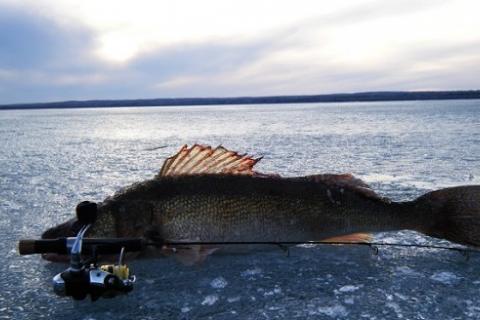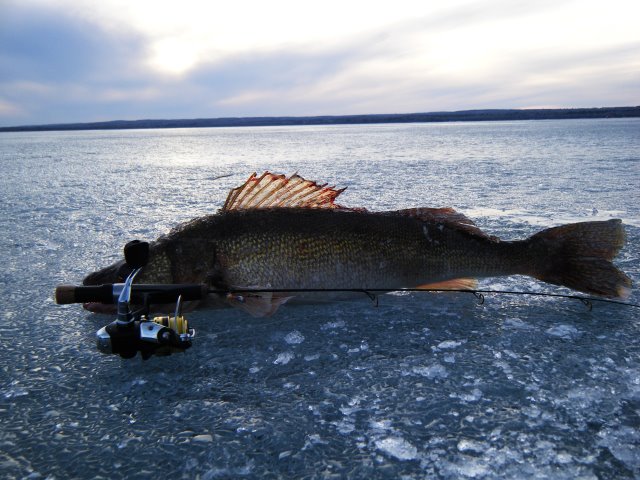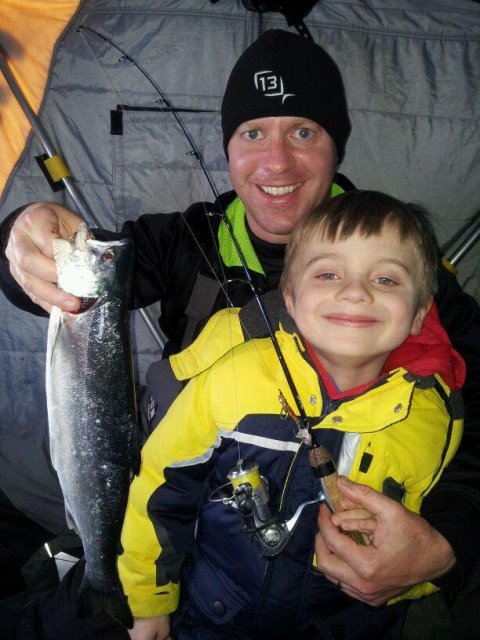
Ice season is here, and it's time to unpack and prepare!
While looking through your fishing gear you pick up and test your ice rods. You remember the fish you iced on them last year, especially that nice walleye. Sure they work but a few fish last year really pushed the limits of these rod and reel combos. Then there was your buddy who caught that giant sturgeon on a reel just like you're holding. He had to hand line it because the reel blew up under the pressure of the big fish. What a fish that was! That story would be told and retold for years to come.
Boy, you think, should I have the chance at a fish like that, I want my rod to handle it. These old rods are still serviceable, but really I've moved past the point in this hobby for 'serviceable rods'. It's time for a nice ice combo.
Where to start?
1. Figure out what it is you really want.
Most often when you think of buying an ice rod and reel you likely think of a combo. After all the vast majority of ice set ups are combos rather than ice rods and ice reels. Combos are likely a less costly option, however, that cost savings comes from somewhere.
Most often the reel is where cost is cut to make a combo 'affordable'. A quality reel strapped to your ice rod can make or break your day on the ice. For that matter, the same thing can be said about the rod you choose.
When you set out on your quest to find the perfect ice combo for this season there are many things to consider that will affect how you feel about your purchase into the future. Before you leave home, you need to decide what it is that you want the combo to do for you. Consider what you'll be using the new combo for. If 90% of your fishing is anticipated to consist of small lakes for pan fish then you don't need or want a 30 inch heavy action rod. Conversely if you plan to fish deep water or you'll be targeting trophy pike you don't want a reel with a miniature size spool.
Odds are you have some buddies who ice fish. It's a good idea to chat with them about what rods they like or don't like for your chosen application. If you have one, go to the tech buddy first, that guy who's always buying all the latest and greatest gear. Odds are he's spent a bunch of money on stuff that both works great and doesn't. Get his opinion, then hit up your other friends for theirs. You can also do some online research. Type things like "best ice rod for walleye" or "ice combo for bluegill" into your search engine and read some posts on message boards. Better yet, ask these questions of members on boards like you'll find at IcefishingFIRST.com or post the question on a Facebook page like Chequamegon Bay Fishing Fanatics.
I'm a tech guy so I love to see and answer that type of question. Just keep in mind, people might be biased towards certain gear. You'll want to find out why they like what they do not like. Once you've got a general idea of what types or brands of rods and reels you're interested in, it's time to head to the store. I recommend leaving the money at home so you don't succumb to an impulse buy. Just look at what's there then think about it first.
2. Learn what features to look for in a great rod.
Ice fishing rods have come a long way in the past 10 years, especially the past three. The major advancement in the past three years was manufacturers adding fast action tips to ice rods. This creates a whole new category of rods that fit the bill right down the middle of the road. The blank is not a noodle, but it's also not a pool cue with guides glued on. Fast action tips give you added sensitivity and better hit detection as well as added flex, which results in give while fighting a fish. The middle of the blank on these rods is fairly stiff depending on the action, which gives you backbone to move a larger fish. Find a rod with a fast action tip that you like the action and feel of I recommend it over other more basic rod types.
You may believe you need a light action rod for pan fish. This was true several years ago, but no longer is the case. There are fast action tips, and heavier actions that come with specialized bobbers. Some spring bobbers are patented built ins like St. Croix's Legend series, while others are colored tips on a fast action rod like some of the new Frabill models are sporting.
Even with a heavy action you should add a specialized bobber if the rod doesn't come rigged up with one. When selecting a heavy action rod, remember the "fun" factor. An extra heavy rod isn't going to be as much fun reeling in perch as a  medium light action will be.
medium light action will be.
While looking at rods in the store I recommend picking them up and putting them through the motions. Check the flex of the blanks. There can be a great deal of difference in actions between manufacturers. Is it sensitive? You can find out by lightly tapping the tip on something. If you can't feel that tap in the handle you may not feel a fish hit either. If you plan to go without a bobber at any point I don't recommend even considering an un-sensitive rod.
Check out the guides. If you're using braid you want the style of guides that will handle braid. Think about where you'll use the rod. If you plan to use it out of a heated shelter in the elements, you will want a nice big tip and larger guides to avoid icing up. If you'll be spending your time in a heated shelter, consider the smaller guides which can give you greater sensitivity.
Pay attention to the handle. I have just about all the available handle types. Plastic or rubber coated handles tend to be the least sensitive, with cork and graphite composite being the most sensitive. Make sure the handle fits well in your hand. It could be a great rod but an uncomfortable handle can make you not want to use it for a long day on the ice. It's important to match the rod action and length to the fish species you plan to target. Ice rods are getting longer and shorter depending on what you fish for.
The most versatile ice rods are in the 'medium action' category. A medium light or medium with a fast action tip or built in bobber system can work well for both pan fish and game fish. A good multi- purpose ice rod is somewhere in the 18-24" range.
3. Don't sacrifice quality in your ice reel.
 |
| Spinning reels, like the Shimano Sienna FD, tend to have better drags. |
Once you've got the rod figured out consider what you want for a reel. I prefer spinning reels over in-line reels because spinning reels tend to have better drags. It's very rare that I pick up a combo and am impressed with both the rod and reel. Often they are paired incorrectly (a reel with a tiny spool on a 28 inch rod) or the rod or reel quality do not match. When looking for a great ice reel, leave the ice section altogether and head over to the summer reels. Summer reels tend to be much higher quality and will last longer.
I don't buy reels without being able to handle and test them. Open and close the bail with your hand. Does it click over smoothly? Open the bail then snap it closed by reeling. Did it stick or did it snap over easily? Turn the drag knob back and forth. Does it feel sensitive or are there spaces between clicks or is it clicking unevenly? Give the reel handle a spin and hold the reel up to your ear. Any squealing or noise? No instant anti-reverse is a deal breaker.
Instant anti-reverse is incredibly important in an ice reel where a tiny slip could mean the difference between a good hook set and a miss. I like the Abu Garcia Cardinal series for my ice reels. I use either a 10 or a 20 depending on rod size. I also like the added benefit that I can use these year round; they match up nicely to my light and ultra-light soft ater rods. Spool size is also an important consideration. A very small spool may have you running out of line when you hook a monster fish, suffering also from a very slow retrieve ratio. That's a large part of the reason I like a summer reel over ice reels.
4. Pair the right fishing reel with the right line
For ages the ice industry has touted micro monofilament line in 2-6 lb test to be what you need for ice fishing. Why? I ask that a lot. The fact is that technology and gear have really made the necessity of light line obsolete.
A growing number of ice anglers now recognize the value of braid tied off to fluorocarbon. Braid gives you excellent abrasion resistance while a fluorocarbon leader adds invisibility that is better than monofilament (even tiny diameters) while also adding abrasion resistance. Bite detection is also better with braid. To date I've never broken off braid while ice fishing, yet I've lost fish that had snapped off monofilament against the ice edge or because of unanticipated blazing runs from a big fish. Every time the fish surprises me with power and spped I was not anticipating, I think "this could have been someone else's 'fish story', the one that got away."
also adding abrasion resistance. Bite detection is also better with braid. To date I've never broken off braid while ice fishing, yet I've lost fish that had snapped off monofilament against the ice edge or because of unanticipated blazing runs from a big fish. Every time the fish surprises me with power and spped I was not anticipating, I think "this could have been someone else's 'fish story', the one that got away."
I like to use 15 lb braid on my ice reels, and I've found the color of line can be important. For the clear water of Chequamegon Bay of Lake Superior I like pink, yellow, blue, or red. Some fish species react negatively to certain colors and will travel up and down in the water column so I stay away from white, black, and dark green on my ice rods.
Don't feel you have to use a light pound test fluorocarbon for the leader. That sort of thinking is for monofilament.
Fluorocarbon is nearly invisible to the fish. I recommend using 10-15 lb Fluorocarbon on the Great Lakes. Honestly, I use the same rods on smaller inland with equal success. If you decide to switch yours over, be aware that the 15 pound fluorocarbon might be too large for the eyes of some of the tiny pan fish jigs. I problem solve this with a Berkley cross lock snap swivel size 12, 30 lb. This has the added benefit of allowing for easy change ups to other jigs.
Ultimately, fishing is always about the chance of catching trophy fish. That chance can come at any time and is often when you'd least expect. If you want to land a trophy you need to use line that will result in that happening. Last year I caught a 28 inch walleye on my St. Croix Legend pan fish rod and a single waxie on a Clam Epoxy Drop jig. I was alone and targeting crappie when a huge mark lifted off the bottom and moved up to my jig in a slow determined fashion. A small tick on the spring bobber was all she gave for a hit. I set the hook and instantly drag was burning off the reel. The fish was far too large for the rod but since I had a good reel with a quality drag and 15 lb braid to fluorocarbon leader I was able to land it by pointing the tip of the rod at the hole and fighting the fish on the reel, rather than the rod.
It was an epic battle, and was one that would have ended differently had I been using light line. Take your time shopping for your next combo and consider these tips. Next year you'll be telling more catch stories and less about the ones that got away!
Unpacking your ice gear for the 2016-17 season you'll be nodding at your new 2015/16 combo in satisfaction, knowing that it's going to do everything you need it to.
About the Author: Brian Worrall offers a life time of dedicated multi-species and all season angling expereice from a practical viewpoint. Join Brian on his Chequamegon Bay Fishing Fanatics page on Facebook!
by Pros4- 1Source's Brian Worrall
- 14445 views

